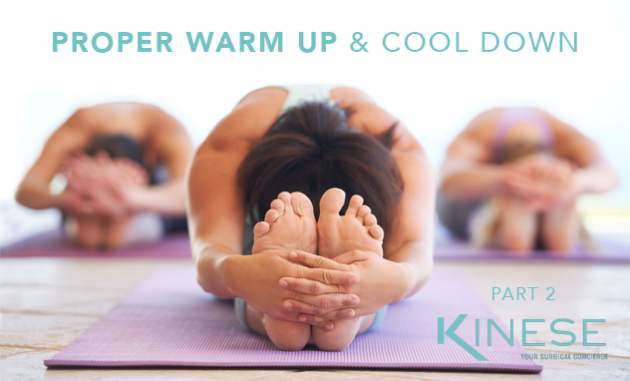Proper Warm-Up & Cool Down

Part Two: Proper Warm-up & Cool-down
In our latest install of Injury Prevention for Athletes, we highlighted four key components to proper physical conditioning that can be incorporated into just about any training routine. While consistent physical conditioning is a vital component in ensuring injury-free athletic performance, there is perhaps a more critical pre-requisite to any athletic endeavor, including physical conditioning. Proper warm-up and cool-down are fundamental aspects in reducing overall risk associated with athletic injury.
Maintaining a consistent and well-designed physical conditioning program is important, but only effective if athletes take the proper measures to ensure that the conditioning program itself precedes without injury. Furthermore, committing to proper warm-up and cool-down routines in any workout will greatly contribute to future injury-free performance.
Warm-up
We all lead busy lives, however skipping a warm-up to gain a few extra minutes of time is effectively putting athletic performance at a disadvantage and increasing the likelihood of sustaining an athletic injury. In its most basic form, a warm-up is a period of time in which the body prepares for more advanced, prolonged or strenuous exercise.
A warm-up should consist of two elements:
- Low-Intensity Cardio: By partaking in five to ten minutes of low-intensity cardiovascular activity, heart rate is increased and the flow of blood and oxygen becomes readily available to working muscles groups.
- Stretching & Flexibility: Once muscles have been properly warmed, a period of time focused on flexibility and stretching can be implemented in order to increase range of motion and prepare soft tissue and joints for athletic performance.
An effective warm-up serves as a time to transition muscles into their intended purpose, or planned athletic activity. As such, warm-ups will be unique for different athletic pursuits. As an example, soccer players will have a distinctly different warm up pattern than swimmers would resulting from the varied movement patterns unique to each sport. It’s also important to recognize the involved timeframe that may span between warm-up and intended workout. If too much time is allowed between events, the body naturally returns to a resting state rendering the warm-up ineffective for achieving its intended purpose.
Cool-down
Much like a warm-up prepares the body for physical activity, the cool-down process helps return the body back to a normal state of equilibrium. Cooling down the body is just as important as warming it up. Following prolonged and/or intense athletic activity, a cool-down is essential in returning heart rate and body temperature back to regular levels. Throughout a workout waste products build up within the body and muscle fibers, tendons and ligaments become damaged. The cool-down process immediately begins repairing these damages and alleviates muscle soreness.
Following exercise, blood and oxygen remain actively rushing throughout the body, immediately terminating exercise can cause blood pooling in the muscles which creates waste products such as lactic acid. Cooling down keeps blood circulating and helps prevent lactic acid build up, while appropriately bringing oxygen and nutrient rich blood supply to appropriate muscles, tendons and ligaments for repair.
Similar to a warm-up, a cool-down also consists of low-intensity cardio and stretching. These elements help heal the body during the recovery process and prevent future damage. The cool-down process should also consist of appropriately re-hydrating and taking in healthy nutrition that was depleted during the process of physical exercise (we will revisit hydration and nutrition more in depth in a future blog post).
Kinese is a company that facilitates surgical experiences for those who desire a deeper level of personalized explanation, treatment and care. We believe our clients deserve immediate access to the very best minds in medicine without having to negotiate the bureaucratic, complex and flat-out confusing systems that surround the greater healthcare market. Alongside our physicians, we promise to deliver the highest standard of care available.
